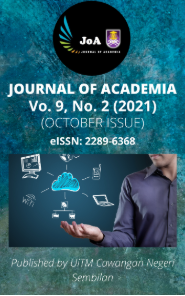THE NEXUS BETWEEN INFLATION, TRADE, AND FDI WITH ECONOMIC SUSTAINABILITY IN MALAYSIA
Keywords:
ANS Rate, Sustainable Development, MalaysiaAbstract
The Adjusted Net Saving (ANS) rate indicator was introduced by the World Bank in the early 1990s to
measure the sustainable development path of a country. Since then, the indicator has been widely
recognized for its comprehensive economic sustainability measurement. This paper explored the nexus
between inflation rate, international trade and foreign direct investment (FDI) with the economic
sustainability path in Malaysia from 1987 to 2018. We employed the autoregressive distributed lag
(ARDL) model based on the Bounds test approach to identify the connection among the listed variables.
The result findings showed that in the long run, trade and FDI have a significant positive impact on the
ANS rate while the inflation rate, however, presented otherwise. Following the cointegrating short-run
model, the error correction term indicates a highly significant negative form which confirms the correct
speed of adjustment towards the equilibrium. As the Coronavirus pandemic is currently affecting the
global economy, this study further recommends that investment and international trade policies must be
meticulously be reformulated to ensure sustained development in an emerging economy like Malaysia.
References
Arrow, K. J., Partha Dasgupta, & Mäler, K. G. (2003). The Genuine Savings Criterion and The Value of Population.
Economic Theory, 21, 217-225.
Atkinson, G., & Hamilton, K. (2003). Savings, Growth and the Resource Curse Hypothesis. World Development,
, 1793-1807.
Bağci, R. B., & Gökirmak, H. (2020). Foreign Direct Investments, Trade Policies, and Economic Growth in
Turkey: An ARDL Analysis. Pamukkale İşletme ve Bilişim Yönetimi Dergisi, 7(1), 1-11.
Barbier, E. B., Markandya, A., & Pearce, D. W. (1990). Environmental Sustainability and Cost-benefit Analysis.
Environment and Planning A, 22(9), 1259-1266.
Boos, A. (2011). The theoretical relationship between the Resource Curse Hypothesis and Genuine Savings.
In annual meeting of the International Studies Association Conference, Montreal, Quebec, Canada.
Brundtland, G., Khalid, M., Agnelli, S., Al-Athel, S., Chidzero, B., Fadika, L., Hauff, V., Lang, I., Shijun, M., de
Botero, M. M. (1987). Our Common Future (Brundtland Report).
Carbonnier, G., Wagner, N., & Brugger, F. (2012). The Impact of Resource-Dependence and Governance on
Sustainable Development. CCDP Working Paper, 24.
Engle, R. F., & Granger, C. W. (1987). Co-integration and Error Correction: Representation, Estimation, and
Testing. Econometrica: Journal of the Econometric Society, 251-276.
Farhan, M., & Akram, M. (2011). Does Income Level affect Saving Behaviour in Pakistan? An ARDL approach
to co-integration for empirical assessment. Far East Journal of Psychology and Business, 3(3), 11.
Faridah Pardi, Arifin Md Salleh, & Abdol Samad Nawi. (2015). Determinants of Sustainable Development in
Malaysia: A VECM Approach of Short-Run and Long-Run Relationships. American Journal of Economics, 5(2),
-277.
Hamilton, K. (2000). Sustaining Economic Welfare: Estimating Changes in Wealth per Capita. Paper presented
at the 26th General Conference of The International Association for Research on Income and Wealth, Cracow,
Poland.
Hess, P. (2010). Determinants of the Adjusted Net Saving Rate in Developing Economies. International Review
of Applied Economics, 24, 591-608.
IUCN. (1980). World Conservation Strategy- Living Resource Conservation For Sustainable Development (pp. 77).
Jamal Othman, Roby Falatehan, & Jafari, Y. (2012). Genuine Savings for Malaysia: What Does It Tell?
International Journal of Management Studies, 19(1), 151-174
Jamal Othman, Yaghoob Jafari, & Tamat Sarmidi. (2014). Economic Growth, Foreign Direct Investment,
Macroeconomic Condition and Sustainability in Malaysia. Applied Econometrics and International Development,
, 1-11.
Johansen, S., & Juselius, K. (1990). Maximum Likelihood Estimation And Inference on Cointegration—With
Applications To The Demand For Money. Oxford Bulletin of Economics and statistics, 52(2), 169-210
Keynes, J. M. (1936). The General Theory of Employment, Interest and Money. Cambridge: King's College.
Koirala, B. S., & Pradhan, G. (2019). Determinants of Sustainable Development: Evidence from 12 Asian
countries. Sustainable Development, 28(1), 39-45.
Narayan, P. K., & Saud, A. (2005). An Empirical Investigation of the Determinants of Oman's National Savings.
Economics Bulletin, 3(51), 1-7.
Pesaran, M. H., Shin, Y., & Smith, R. (1996). Testing for the Existence of a Long-run Relationship. Department
of Applied Economics, University of Cambridge. DAE Working Papers, pp. 9622.
Pesaran, M. H., Shin, Y., & Smith, R. J. (2001). Bounds Testing Approaches to the Analysis of Level Relationships.
Journal of Applied Econometrics, 16(3), 289-326.
Solow, R. M. (1956). A Contribution to the Theory of Economic Growth. The Quarterly Journal of Economics,
, 65-94.
Solow, R. M. (1974). Intergenerational Equity and Exhaustible Resources. The Review of Economic Studies, 41,
-45.
Downloads
Published
Issue
Section
License
Copyright (c) 2021 Journal of Academia

This work is licensed under a Creative Commons Attribution-NonCommercial-NoDerivatives 4.0 International License.












